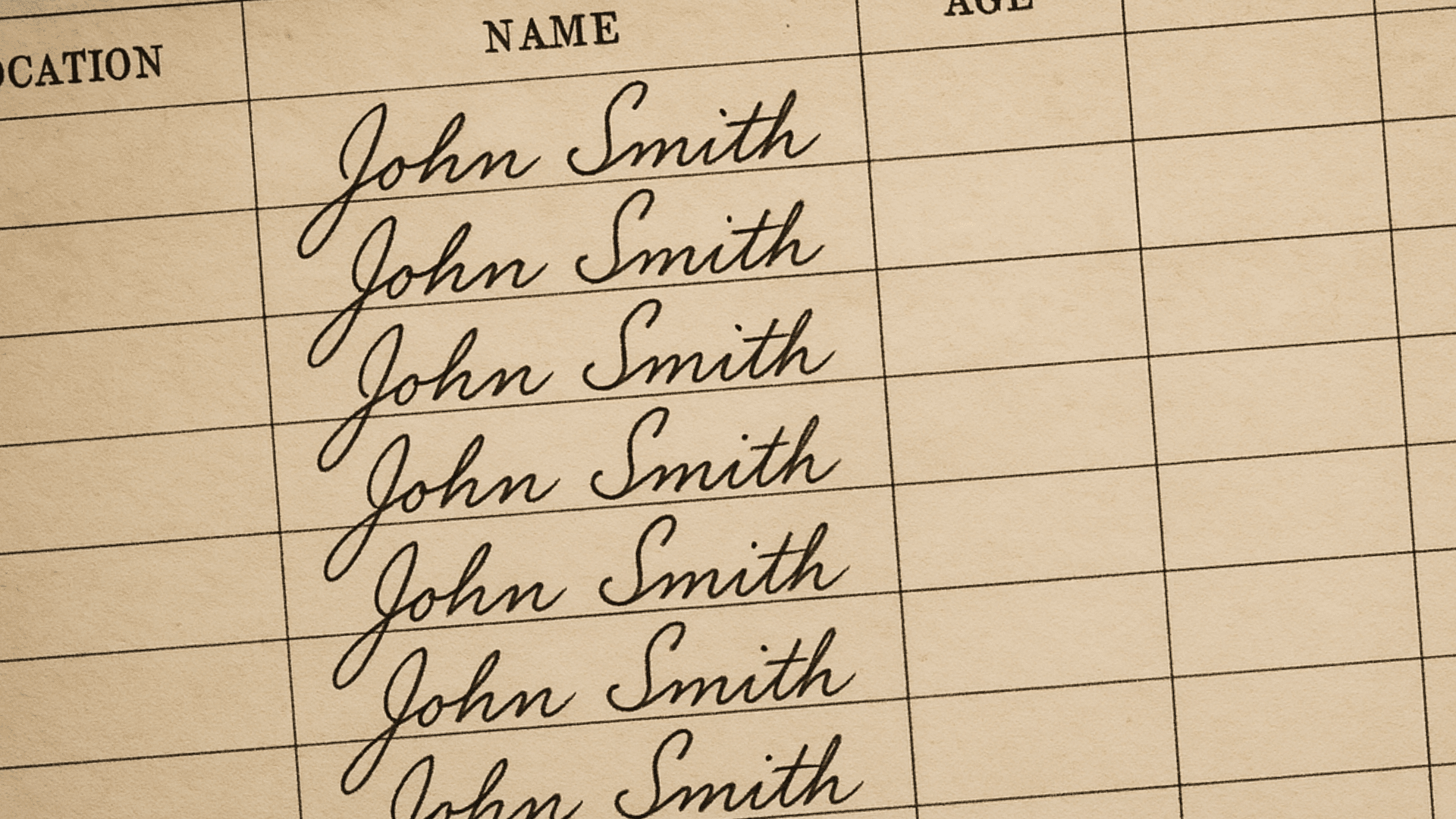Sign up for the Family Tree Newsletter! Plus, you’ll receive our 10 Essential Genealogy Research Forms PDF as a special thank you.
Get Your Free Genealogy Forms
"*" indicates required fields
Middle names are probably most useful when a child has done something very wrong. My grandson knows when he hears the double salvo of “Lincoln Michael!” that he’d better pay attention.
But middle names can also be useful in genealogy, and not just for separating “your” John Quentin Smith from all the other John Smiths. Middle names might reveal family ties. Positioned between first names and surnames, they could derive from either—or they might simply celebrate some then-popular historical figure. For example, as far as I know my distant 19th-century cousin Zebulon Pike Clough was not related to the discoverer of Pike’s Peak.
Zebulon’s parents, however, were relatively early adopters when it comes to middle names. None of the Pilgrims on the Mayflower was recorded as having a middle name. The Virginia Settlers Research Project found that only 5 colonists out of 33,000 before 1660 had a middle name. Most of the Founding Fathers had no middle names; only three signers of the Declaration of Independence had three names, and two of them were brothers. Even post-independence, only three of the first 17 US presidents had middle names.
The tradition of middle names dates back to ancient Rome, when important people like Gaius Julius Caesar went by three names. Middle names mostly died out with the Roman Empire, though Arabic and Spanish families incorporated extra names to honor previous generations. Aristocratic families in Italy began adding middle names in the early 13th century, and the practice spread as an embellishment to the tradition of naming children after saints. A middle name let parents name a son Sebastian after the saint, as well as Robert after a favorite grandfather, for example.
In England, early common law recognized just two names for children—except for royalty and nobility—and extra names were simply discarded by authorities. Mostly immigrants from England, the settlers of New England were equally parsimonious in naming: “Middle names are a modern innovation,” The Vermont Record and Farmer reported in 1873. “Not one person in a hundred in New England a century ago had more than two names.” The term “middle name” first appeared in an 1835 Harvard University periodical.
German families had begun adding middle names in the 1600s—think Johann Sebastian Bach—and German immigrants brought the practice to their settlements in America. Pennsylvania Germans were among the first to routinely give children middle names.
By the Civil War, middle names had become common in the US. By 1900, nearly every child was given a middle name. World War I enlistment forms were among the first official government documents to provide a space for a middle name.
As you research your own ancestors, you may be tempted to scan over that extra name and zero in mostly on the surname. But that name might hold meaning that is worth exploring more deeply. Below are some things to keep in mind when you stumble upon ancestors’ middle names.
Look for Middle Name Clues
The most obvious use of middle names in genealogy is differentiating between individuals with the same first and last names. Even just middle initials can be helpful here. But middle names can also suggest family ties, especially among earlier ancestors. Common sources of middle names include a parent or grandparent’s first name, or the maiden name of the mother or a grandmother.
This use of maiden names, which became especially popular in the second half of the 19th century, turned surnames into middle names—a boon for genealogists. My much-removed cousin Thomas Oglesby Rosser, for example, got his middle name from his mother’s maiden name, Elizabeth Oglesby. Another in the Oglesby clan, Lucy Christian Oglesby, got her first and middle names from her grandmother, Lucy Christian. Her brother, Urbane Bradley Oglesby, derived his middle name from their mother, Ruth Bradley. (If that unusual first name Urbane shows up anywhere as a middle name in my family tree, I’ll bet there’s a connection.)
John Quincy Adams, the first US president to have a middle name, was christened according to this maiden-name pattern. His maternal grandmother was Elizabeth Quincy. (Other sources say that he was named after his maternal great-grandfather, John Quincy, her father; in any case, “Quincy” was a family surname.) Adams’ mother, the nation’s second first lady, likewise carried the Quincy name, born Abigail Quincy Smith.
Other presidents whose parents followed the maiden-name tradition included Rutherford Birchard Hayes, William Howard Taft (Howard was the maiden name of his paternal grandmother, Sylvia), John Fitzgerald Kennedy, Lyndon Baines Johnson, Richard Milhous Nixon and Ronald Wilson Reagan. Franklin Pierce, the 14th president, may have had the middle name Kendrick—his mother, Anna’s, maiden name—but no documents have been found to prove that.
Other relatives often got honored with middle names. The second president to sport a middle name, William Henry Harrison, got his middle name from a paternal uncle, Henry Harrison. The next, James Knox Polk, was named in honor of his maternal grandfather, James Knox. Much later, Franklin Delano Roosevelt was middle-named after his great-uncle, Franklin Hughes Delano.
Sometimes middle names get passed down in a family in the same position, across generations. If the name is unusual, that can be a clue to a connection. In my own family tree, my third-great-grandfather, William Mandred Chapman, passed that middle name on to his grandson, George Mandred Chapman.
Watch Closely for Switches and Surprises
Another presidential example, Ulysses Grant, is a cautionary tale for those researching with middle names: He was actually born Hiram Ulysses Grant, named for his maternal grandfather and the hero of the Odyssey. His West Point admission paperwork, at age 17, flipped the names. You may also have seen him called Ulysses S. Grant, but that was never his name—just a nickname, “U.S.” (as in the United States whose union he preserved) Grant.
A few years later, Stephen Grover Cleveland similarly went by his middle name from early in childhood, and served as President Grover Cleveland. The third president to go by his middle name was Thomas Woodrow Wilson, who switched to Woodrow as an adult. Then there was John Calvin Coolidge, named for his father but called Calvin from early childhood.
The lesson for genealogists in these presidential name changes is that a first name might well have started out as a middle name. (In fact, my mountaineer-named cousin, Zebulon Pike Clough, later in life went simply by Pike Clough.) It’s not just presidents who pulled this switch: Author Rudyard Kipling’s actual first name was Joseph; Rudyard was his middle name. Flipping first and middle names—and sometimes flipping back again—was especially common in the American South. My Alabama great-grandfather William Francis Dickinson, for example, was mostly known as Frank, or by the initials W.F.
Then there’s Harry S Truman, whose middle initial didn’t stand for anything at all. As the story goes, the future president’s parents couldn’t decide on a single name, so they settled on an initial to honor both his paternal grandfather, Anderson Shippe Truman, and his maternal grandfather, Solomon Young.
Professional genealogist Clare Kirk suggests another surprising twist on the sources of middle names: “One of the most common reasons for a child to be given a surname as a middle name was when the parents weren’t married. If a child had the same surname as his/her mother, and a middle name that looked like a surname, there’s a very good chance that the child’s middle name was the biological father’s surname. In some cases, the middle name of an illegitimate child may be the only clue, other than DNA, to the father’s identity.”
From Fame to Middle Name: Don’t Assume Connections
Before you jump to the conclusion that your ancestor John Jefferson Smith was the illegitimate child of Thomas Jefferson, keep in mind that some middle names have no lineage connection at all. Parents often chose first as well as middle names to honor some historic hero or other famous person. One study, for example, found that 40 percent of families in the Chesapeake region had a son named George, after George Washington; some parents went all the way and added Washington as the middle name. My family tree includes George Washington Segrest as well as John Washington Hungerford—neither related, as far as I can tell, to the first president.
By the mid-1800s, the popularity of famous names led to middle names in America that were largely unknown back in Europe except as surnames: Washington, Jefferson, Jackson and so on. Besides presidents and generals, religious leaders sometimes were commemorated with middle names, like Luther or Wesley.
Middle names might also honor less famous individuals who were nonetheless important to the family. These might include the family pastor, the minister who baptized the child, local politicians or business leaders, even neighbors.
Verify That a Name Actually Belongs in the Middle
Other middle names aren’t truly stand-alone monikers at all, but part of the first or last name. Women in particular are often given double first names like Mary Jo, Mary Jane, Betty Jean, Rose Marie or Sally Mae. (“Sally Mae” is so common that “Sallie Mae” has become shorthand for SLM Corp., a consumer banking corporation that began as a government entity for student loans.)
Surnames also sometimes come in two parts. French and Spanish families often use “la” or “de la,” meaning “the” or “of the,” as in la Fleur or de la Peña. The Dutch and German equivalents look more like middle names—van and von, respectively, meaning “of” or “from.” So Rembrandt van Rijn means “from the Rhine” and Ludwig van Beethoven means “from Bettehoven.” (Although born in Germany, Beethoven was the son of a transplant from the Flemish region of Belgium, which also uses “van” rather than “von.”) The Red Baron was Manfred von Richthofen, though like many Germans he also had two middle names, Albrecht and Freiherr.
Slightly different, the prefix “Mac” found in Scottish and Irish Gaelic names means “son.” So Mac Connell would literally mean “son of Connell,” much like the “-son” suffix on English and Scandinavian names like Johnson. Less familiar but similar are the Anglo-Norman “Fitz” and the Welsh “Ap” and “Map.” Don’t confuse these with true middle names; in entering into genealogy software, include these prefixes in the surname field.
Where to Hunt for Middle Names
Even after middle names became commonplace, they didn’t necessarily make it onto the records genealogists rely on. Forms for the US census over the years simply asked for “Name,” so it was up to the enumerator whether to record middle names and up to the head of household whether to volunteer them. You’re most likely to discover middle names in the records created at the beginning and end of an ancestor’s life, such as birth and death certificates and obituaries.
Gravestones, given their limited space and carving costs, often omitted middle names. Although FindaGrave has a search field for middle names, for example, the first dozen pages of results for William Chapman contain zero middle names. Searching just for an unusual middle name, however, might be worth a try; “Mandred” turns up 36 hits, including my George Mandred Chapman.
Church and marriage records can also reveal middle names, as can some family histories and biographies. As for military records, Civil War service records may give a middle initial, often with only a first initial (“Dickinson, W.F.”). World War I draft cards frequently include a middle name or at least an initial, while World War II enlistment records typically give only a middle initial.
In general, the more formal the record, the more likely it is to include a middle name if there was one. In that sense, you could think of the angry parent’s use of an errant child’s middle name as the most formal of all.






